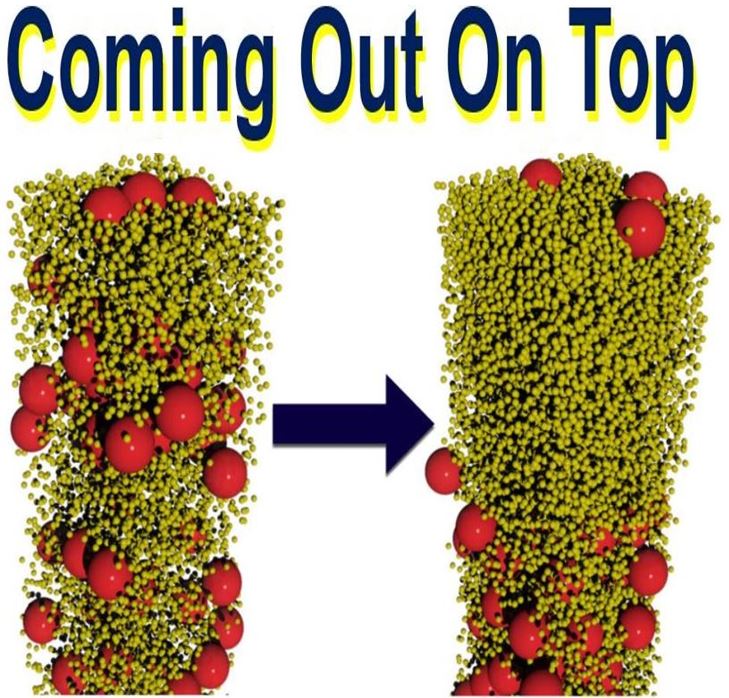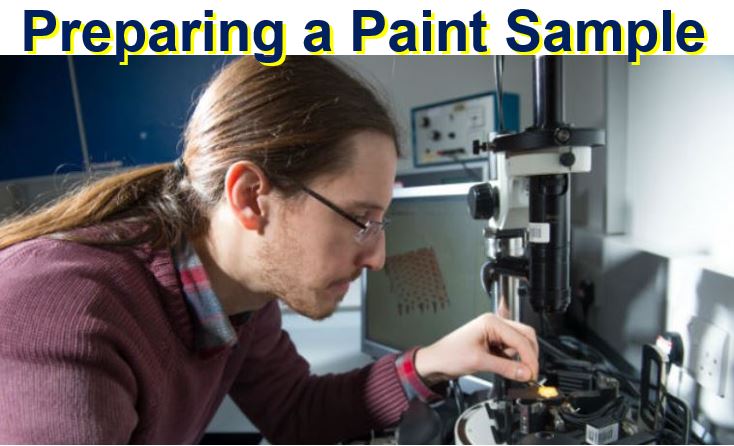Weird stuff happens when you watch paint dry, says a team of British and French scientists, who have given a new meaning to the activity we all thought was the most boring possible. Put simply, they found that as paint dries, small particles team up and push away large ones – the little ones come out on top.
Dr. Andrea Fortini, from the University of Surrey, and colleagues at the Université Claude Bernard, Lyon, France, wrote in the journal Physical Review Letters (citation below) about a new physical mechanism that separates particles according to their size during the drying of wet coatings of paint.
The authors say their discovery will help improve the performance of several everyday consumer goods, from sunscreen to paint.
 A suspension of yellow (small) and red (large) particles undergoes spontaneous size stratification as the surrounding liquid evaporates. (Image: physics.aps.org. Credit: A. Fortini/Univ. of Surrey)
A suspension of yellow (small) and red (large) particles undergoes spontaneous size stratification as the surrounding liquid evaporates. (Image: physics.aps.org. Credit: A. Fortini/Univ. of Surrey)
Coating spontaneously forms two layers
The scientists used materials experiments and computer simulation to show how when coatings with different sized particles such as paints dry, the coating spontaneously forms two layers.
This mechanism could be used to control the properties at the bottom and top of paint coatings independently. This would help improve the performance of coatings across a wide range of industries, from pharmaceuticals, agriculture to beauty.
Lead author, Dr. Andrea Fortini, from the University of Surrey’s Department of Physics, said:
“When coatings such as paint, ink or even outer layers on tablets are made, they work by spreading a liquid containing solid particles onto a surface, and allowing the liquid to evaporate.”
 Co-author Nacho Martín-Fabiani preparing a paint sample to be analyzed with the Atomic Force Microscope. (Image: University of Surrey)
Co-author Nacho Martín-Fabiani preparing a paint sample to be analyzed with the Atomic Force Microscope. (Image: University of Surrey)
“This is nothing new, but what is exciting is that we’ve shown that during evaporation, the small particles push away the larger ones, remaining at the top surface whilst the larger are pushed to bottom. This happens naturally.”
This kind of self-layering in a coating could be extremely useful, the scientists believe. For example, in a sunscreen, most of the sunlight-blocking particles could be designed so that they push their way to the top, while the particles that can stick to the skin would be at the bottom of the coating.
Engineering coating done at microscopic level
Dr. Fortini continued:
“Typically the particles used in coatings have sizes that are 1000 times smaller than the width of a human hair so engineering these coatings takes place at a microscopic level.”
Further research is currently underway by the team, who are trying to understand how to control the width of the layer by altering the type and amount of small particles within the coating. They are also exploring their possible usage in industrial products such as adhesives, inks and paints.
Alexander Routh, a chemical engineering lecturer at the University of Cambridge, said regarding the study:
“[The study presents] a novel, yet simple, mechanism for the observed accumulation of small particles. It opens up a whole new avenue for how small particles will arrange themselves into structures.”
The study is being funded by the EU project BARRIERPLUS, which is seeking to find ways of reducing the usage of environmentally harmful volatile organic compounds in paints.
Citation: “Dynamic Stratification in Drying Films of Colloidal Mixtures,” Andrea Fortini, Pierre-Yves Dugas, Franck D’Agosto, Elodie Bourgeat-Lami, Ignacio Martín-Fabiani, Jennifer Lesage De La Haye, Muriel Lansalot, Joseph L. Keddie, and Richard P. Sear. Physical Review Letters. 116, 118301 – Published 18 March 2016. DOI: http://dx.doi.org/10.1103/PhysRevLett.116.118301.
Video – Small particles separate out by size
Small yellow and large blue particles stratify by size as the water they are contained in evaporates. In experimental realizations of this effect, the researchers observed stratification over the course of a few hours.

